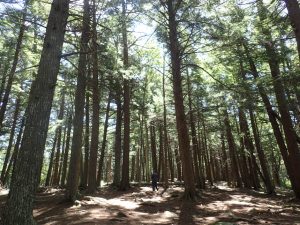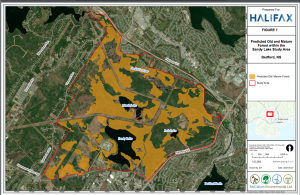 I have made use of the Forest DCL (Development Stage Layer) in the NS Provincial Landscape Viewer to illustrate the abundance of Mature and Muti-Aged-Old Forest in the area of Sandy Lake, e.g. see the map at the top of the page Mature/OG Forest.
I have made use of the Forest DCL (Development Stage Layer) in the NS Provincial Landscape Viewer to illustrate the abundance of Mature and Muti-Aged-Old Forest in the area of Sandy Lake, e.g. see the map at the top of the page Mature/OG Forest.
Recently I learned that this layer had been updated, and checked it out in relation to the Sandy lake area. To my surprise, the new DCL reclassified some significant areas I knew from ground observations to be Old Mature or Muti-aged/Old Growth and that had been classified as such in the 2017 version of the map; the reclassification now identifies these areas as Early Mature Forest – including the 200+ year old hemlock stand on ‘The Peninsula’.
I followed up with Dr. Peter Bush at NS Natural Resources and Renewables. They are now working to correct these errors. Read more on www.versicolor.ca/nstriad
In the meantime, I suggest making use of the map in Fig 7/page 28 of the McCallum Report Sandy Lake Ecological Features Assessment (2022) for a recent assessment of the extent of Old and Mature forest in the area of Sandy Lake.

Predicted Old and Mature Forest within the Sandy Lake Study Area. Screenshot of Fig 7 in McCalkum report.
From the description (p.27 of the Report):
Old/ Mature Forest
Old Forest is defined as a stand or collection of stands containing old growth and/or mature climax conditions (NSDNR 2012). Mature climax is a forest stand of trees aged 80 to 125 years old and old growth forest is a stand with trees 125 years or older, with at least half of the basal area composed of climax species, and the total crown closure is a minimum of 30%.In absence of adequate data for forest stand age, the layer was built using tree height and species data and available field data. A Nova Scotia Ecological Landscape Analysis report classified mature forest as stands with a height >11 m in their modelling exercises (Stewart and Neily 2008). Climax stands in Nova Scotia are typically dominated by Hemlock, Red Spruce, White Pine, Sugar Maple, Yellow Birch, and American Beech (NSDNR 2012). The layer used in this model therefore included polygons with any of the climax species as the primary or secondary species and tree height >11m. The polygons were then adjusted to include areas with field-validated Old Forest, and areas known to be clearcut were removed (Figure 7).
References:
Nova Scotia Department of Natural Resources (NS DNR). 2012. Nova Scotia’s Old Forest Policy. Accessed from https://novascotia.ca/natr/library/forestry/reports/Old-Forest-Policy-2012.pdf
Stewart B and P Neily. 2008. A procedural guide for ecological landscape analysis: An ecosystem approach to landscape level planning in Nova Scotia. Prepared for Nova Scotia Department of Natural Resources.
In a discussion of a draft of the report with McCallum Environmental on Mar 29, 2022, they told me that they had used the distribution of Big Trees as reported in my iNaturalist project Big Trees of Sandy Lake & Environs (Bedford, Nova Scotia) to check the veracity of the model, and that there was good coincidence the distribution of the Big Trees with their predicted occurrence of Old and Mature Forest.
